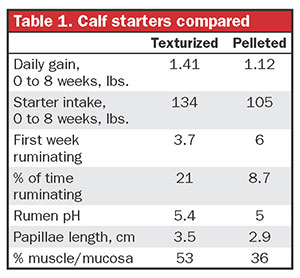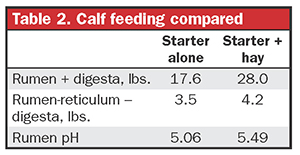The author is the executive vice president for the American Registry of Professional Animal Scientists (ARPAS). Learn more at www.arpas.org.

When a pendulum swings out farther in one direction than normal, it may swing back too far in the other direction. A correction can take some time later on. This analogy has some relationship to dairy calf feeding programs over the past century.
Cornell University researchers in 1923 developed a program to feed whole milk to calves for only one month followed by a gruel or very early version of a ground calf starter to conserve milk and wean calves early. That was the advent of the early weaning calf program.
Other Cornell researchers in the 1950s, led by Dick Warner, found that it was the volatile fatty acids (VFA) produced in the rumen that actually led to rumen papillae development and the function of a calf’s rumen. That being the case, it was not the provision of dietary forage per se since VFAs, in the order of butyric, propionic, and then acetic, lead to rumen papillae development — nearly the opposite order of that produced by ruminal forage and fiber fermentation. Given this situation, there needed to be some way to avoid ruminal acidosis in young calves if fed high-grain calf starters with no dietary forage.
A philosophy shift
I happened to be a graduate student at Cornell in the early 1970s when John Porter did a seminal study under the tutelage of Warner. Later, I helped Porter get that study published in 2007 in the American Registry of Professional Animals Scientist (ARPAS) journal.
Either pelleted or texturized starters were fed to calves in an early weaning program that was then in vogue, as noted above. The study extended four weeks beyond the early weaning at 4 weeks of age.

Data in Table 1 showed marked performance benefits for the texturized versus pelleted starter. Why? The particle sizes in the texturized starter caused much more chewing and rumination, which in turn increases salivation. This salivation action buffered the rumen and kept it from being as acidic as rumens in calves fed the pelleted starter. This also enhanced digestibilities of dry matter, acid detergent (ADF), and neutral detergent fiber (NDF) by 5%, 15%, and 12%, respectively. It was not only the additional texturized starter intake, but also its increased digestibility that improved daily gain.
Another swing
A pendulum swing then occurred in the 2000s with studies done at Cornell, Illinois, and Michigan State Universities, in which greater amounts of higher protein milk replacers were fed than the traditional low levels of then popular 20% crude protein and 20% fat milk replacers. Enhanced daily gains were achieved in the first two months of age to more than double the calf’s birth weight. This led to the Dairy Calf and Heifer Association’s Gold Standard goal of doubling a calf’s birth weight by 2 months of age. If a heifer calf weighed 90 pounds at birth, then 1.5 pounds of daily gain would double birth weight by 60 days of age.
But what if that daily gain was exceeded? There is concern about undue fattening if daily gains exceed 2.2 pounds (1 kilogram), as that is the peak of protein deposition in calf and heifer growth.
A series of studies done by Mark Hill and colleagues at Provimi shed light on another issue. When calves were fed more than about 1.5 pounds of milk replacer dry matter daily, in the month postweaning they had lower intake, daily gain, and digestibilities.
Why would that happen?
Apparently, starter intake (all were texturized in these studies) prior to weaning and for at least two to three weeks was inadequate for good functional rumen development when greater than 1.5 pounds of milk replacer dry matter was fed.
There is an inverse relationship between milk or milk replacer intake and starter intake as found by a Penn State review of nine studies. They found that above about 1 pound of milk or milk replacer dry matter fed daily, an increase of 0.25 pound in milk or milk replacer actually reduced starter dry matter intake by about 0.2 pound. Is this a problem in the real world?
National Animal Health Monitoring System (NAHMS) studies were reported in 2007 (average of 4 quarts daily milk replacer fed and calves were weaned at 8 weeks of age) and 2014 (average of 6 quarts daily milk replacer fed and calves were weaned at 9 weeks of age). These were national surveys with virtually no growth measurements. But, from March 2014 to December 2015, a smaller NAHMS survey was done with 104 dairy operations in 13 U.S. states measuring 2,545 heifer calves with 89% being Holsteins. From data published in the Journal of Dairy Science in 2018, I was able to calculate daily gains prior to and after weaning.
Prior to weaning, Holstein calves gained 1.61 pounds daily, but after weaning they only gained 1.32 pounds daily. While there was commendable weight gain prior to weaning, there was an 18% reduction in daily gain after weaning. That is not a good pendulum swing.
Starters are not equal

Another question is what is a well-texturized starter? In a Canadian study, calves were fed a starter labeled “texturized” either alone or with hay. The starter had “14% flatted barley, 13% flatted oats, and 10% steamed corn” for a total of 37% processed grains. Obviously, the starter, while labeled “texturized,” was not well texturized as the rumen pH was only 5.06 (see Table 2). Allowing calves to eat hay helped raise the low rumen pH, but it also created another major issue. Gut fill was 10.4 pounds greater (28 pounds versus 17.6 pounds). This distorted true body weight gain.
Since calves on both treatments had similar ending body weights, that meant calves that also had hay to eat gained about 10 pounds less of true body weight.
What about that low rumen pH?
I believe young calves have low rumen pH because they do not yet have a resident protozoa population. Protozoa keep rumen pH higher in cows by engulfing starch and deaminating amino acids — both of which keep rumen pH from going lower.
An extensive French calf study found that calf rumen pH gradually rose to about 6.5 at 2 months of age (see pages 73 to 77 in my book, Dairy Calf and Heifer Feeding and Management — Some Key Concepts and Practices).
What about feeding some chopped hay or straw with a pelleted starter? You probably are using a pelleted starter to save some money feeding your calves as it costs less than a well-texturized starter, right? But what is the true cost?
How much does it cost to buy some chopped hay or straw, to store it, to handle it, or to chop it yourself? And then how do you blend it with the pelleted starter so calves get no more than 5% of it in combination with the pelleted starter? How do you keep calves from sorting out for the hay just as your cows can do? What is the added cost of all these operations and the quality control of that operation you have assumed? How will you know how much gut fill there is and not true growth in your calves?
Given all these questions, why not bite the bullet and just feed a well-texturized starter — usually 45% or more of corn or oats with little or no processing. For more insight, read “What makes a good calf starter?” in the October 25, 2020, edition of Hoard’s Dairyman on page 648. The well-texturized starter may actually cost you less than the alternative when all costs are considered.
The goal
You want to avoid big pendulum swings in your calf program. Don’t feed so much milk or milk replacer (more than 1.5 pounds dry matter daily) that starter intake is too low or too brief for good functional rumen development before weaning. Feed a well-texturized starter so that pre- and postweaned rumen function is adequate, intake is enhanced, and the likelihood of having a postweaned slump is minimized.











